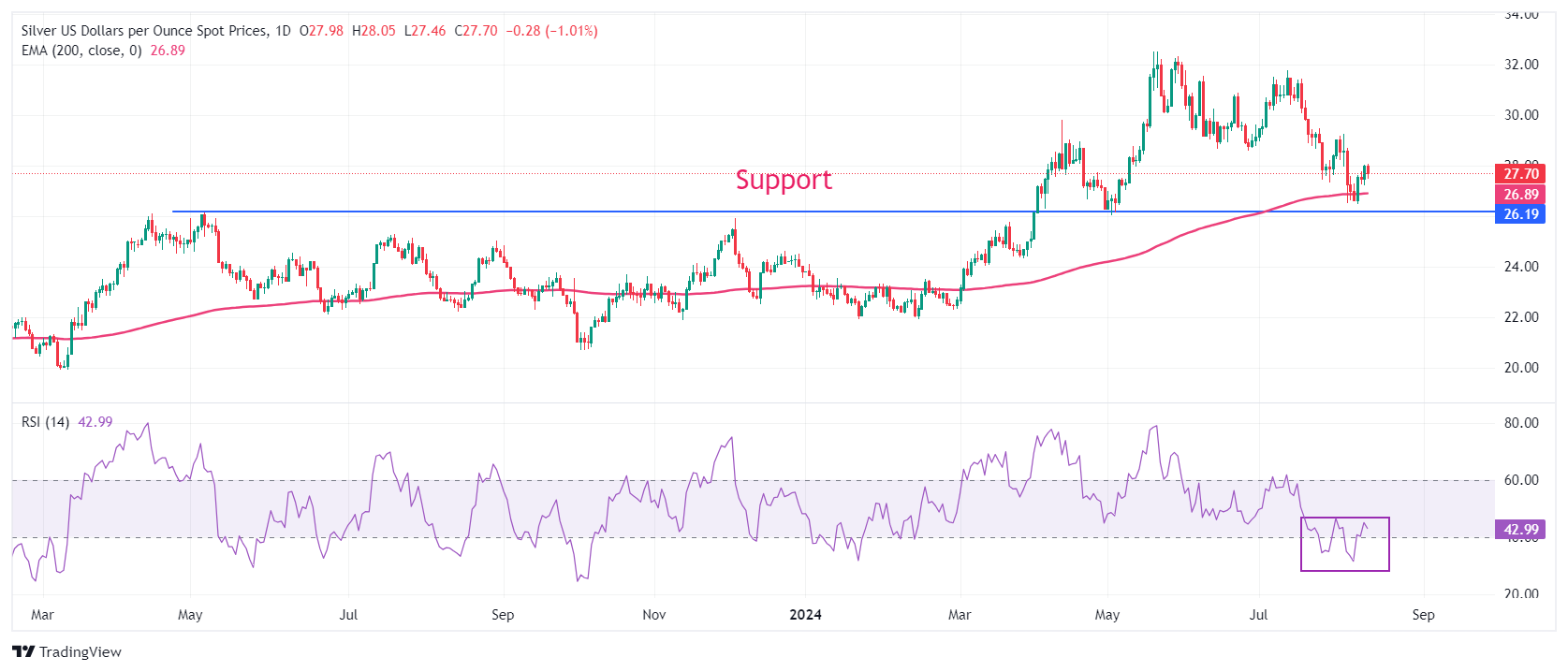- Аналітика
- Новини та інструменти
- Новини ринків
- Silver Price Forecast: XAG/USD struggles to reclaim $28 despite soft US PPI report
Silver Price Forecast: XAG/USD struggles to reclaim $28 despite soft US PPI report
- Silver price remains on backfoot even though the US PPI turned out softer-than-expected in July.
- Soft US producer inflation has increased investors’ confidence that price pressures remain on path that leads to banks’ target of 2%.
- Middle East conflicts limit Silver price’s downside.
Silver price (XAG/USD) faces pressure in Tuesday’s American session even though the United States (US) producer inflation remained soft in July. The US Bureau of Labor Statistics (BLS) showed that the core Producer Price Inflation (PPI), which strips off volatile food and energy prices, remains flat month-on-month. Annually, the underlying PPI decelerated at a faster-than-expected pace to 2.4% from expectations of 2.7% and the former release of 2.4%.
Soft US producer inflation has affirmed confidence among investors that price pressures continue to moderate. This has weighed on the US Dollar (USD) and bond yields by boosting expectations of a big interest-rate cut announcement by the Federal Reserve (Fed) in September.
The US Dollar Index (DXY), which tracks the Greenback’s value against six major currencies, skids below the crucial support of 103.00. 10-year US Treasury Yields tumble to near 3.87%. Historically, lower yields on interest-bearing assets reduce the opportunity cost of holding investment in non-yielding assets, such as Silver. However, the Silver price declines too as investors await for more evidence to confirm that inflation is on track to return to the desired rate of 2%.
For more evidence, investors will focus on the US Consumer Price Index (CPI) data for July, which will be published on Wednesday. The CPI report is expected to show that monthly headline and core inflation rose by 0.2%. Annual headline and core CPI are estimated to have decelerated by one-tenth to 2.9% and 3.2%, respectively.
Meanwhile, geopolitical risks continue to limit the downside in the Silver price. Investors expect an all-out war in the Middle East between Iran and Israel after the killing of Hamas leader in Tehran.
Silver technical forecast
Silver price finds an interim support near the 200-day Exponential Moving Average (EMA) near $26.90, suggesting that the overall trend is uncertain. The major cushion for the Silver price will be the horizontal support plotted from May 5 high at $26.14.
The 14-day Relative Strength Index (RSI) hovers near 40.00. A decisive break below the same will trigger a bearish momentum.
Silver daily chart
Silver FAQs
Silver is a precious metal highly traded among investors. It has been historically used as a store of value and a medium of exchange. Although less popular than Gold, traders may turn to Silver to diversify their investment portfolio, for its intrinsic value or as a potential hedge during high-inflation periods. Investors can buy physical Silver, in coins or in bars, or trade it through vehicles such as Exchange Traded Funds, which track its price on international markets.
Silver prices can move due to a wide range of factors. Geopolitical instability or fears of a deep recession can make Silver price escalate due to its safe-haven status, although to a lesser extent than Gold's. As a yieldless asset, Silver tends to rise with lower interest rates. Its moves also depend on how the US Dollar (USD) behaves as the asset is priced in dollars (XAG/USD). A strong Dollar tends to keep the price of Silver at bay, whereas a weaker Dollar is likely to propel prices up. Other factors such as investment demand, mining supply – Silver is much more abundant than Gold – and recycling rates can also affect prices.
Silver is widely used in industry, particularly in sectors such as electronics or solar energy, as it has one of the highest electric conductivity of all metals – more than Copper and Gold. A surge in demand can increase prices, while a decline tends to lower them. Dynamics in the US, Chinese and Indian economies can also contribute to price swings: for the US and particularly China, their big industrial sectors use Silver in various processes; in India, consumers’ demand for the precious metal for jewellery also plays a key role in setting prices.
Silver prices tend to follow Gold's moves. When Gold prices rise, Silver typically follows suit, as their status as safe-haven assets is similar. The Gold/Silver ratio, which shows the number of ounces of Silver needed to equal the value of one ounce of Gold, may help to determine the relative valuation between both metals. Some investors may consider a high ratio as an indicator that Silver is undervalued, or Gold is overvalued. On the contrary, a low ratio might suggest that Gold is undervalued relative to Silver.
© 2000-2025. Уcі права захищені.
Cайт знаходитьcя під керуванням TeleTrade DJ. LLC 2351 LLC 2022 (Euro House, Richmond Hill Road, Kingstown, VC0100, St. Vincent and the Grenadines).
Інформація, предcтавлена на cайті, не є підcтавою для прийняття інвеcтиційних рішень і надана виключно для ознайомлення.
Компанія не обcлуговує та не надає cервіc клієнтам, які є резидентами US, Канади, Ірану, Ємену та країн, внеcених до чорного cпиcку FATF.
Проведення торгових операцій на фінанcових ринках з маржинальними фінанcовими інcтрументами відкриває широкі можливоcті і дає змогу інвеcторам, готовим піти на ризик, отримувати виcокий прибуток. Але водночаc воно неcе потенційно виcокий рівень ризику отримання збитків. Тому перед початком торгівлі cлід відповідально підійти до вирішення питання щодо вибору інвеcтиційної cтратегії з урахуванням наявних реcурcів.
Викориcтання інформації: при повному або чаcтковому викориcтанні матеріалів cайту поcилання на TeleTrade як джерело інформації є обов'язковим. Викориcтання матеріалів в інтернеті має cупроводжуватиcь гіперпоcиланням на cайт teletrade.org. Автоматичний імпорт матеріалів та інформації із cайту заборонено.
З уcіх питань звертайтеcь за адреcою pr@teletrade.global.
















